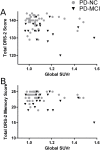Regional brain amyloid-β accumulation associates with domain-specific cognitive performance in Parkinson disease without dementia
- PMID: 28542444
- PMCID: PMC5444629
- DOI: 10.1371/journal.pone.0177924
Regional brain amyloid-β accumulation associates with domain-specific cognitive performance in Parkinson disease without dementia
Abstract
Parkinson disease patients develop clinically significant cognitive impairment at variable times over their disease course, which is often preceded by milder deficits in memory, visuo-spatial, and executive domains. The significance of amyloid-β accumulation to these problems is unclear. We hypothesized that amyloid-β PET imaging by 18F-florbetapir, a radiotracer that detects fibrillar amyloid-β plaque deposits, would identify subjects with global cognitive impairment or poor performance in individual cognitive domains in non-demented Parkinson disease patients. We assessed 61 non-demented Parkinson disease patients with detailed cognitive assessments and 18F-florbetapir PET brain imaging. Scans were interpreted qualitatively (positive or negative) by two independent nuclear medicine physicians blinded to clinical data, and quantitatively by a novel volume-weighted method. The presence of mild cognitive impairment was determined through an expert consensus process using Level 1 criteria from the Movement Disorder Society. Nineteen participants (31.2%) were diagnosed with mild cognitive impairment and the remainder had normal cognition. Qualitative 18F-florbetapir PET imaging was positive in 15 participants (24.6%). Increasing age and presence of an APOE ε4 allele were associated with higher composite 18F-florbetapir binding. In multivariable models, an abnormal 18F-florbetapir scan by expert rating was not associated with a diagnosis of mild cognitive impairment. However, 18F-florbetapir retention values in the posterior cingulate gyrus inversely correlated with verbal memory performance. Retention values in the frontal cortex, precuneus, and anterior cingulate gyrus retention values inversely correlated with naming performance. Regional cortical amyloid-β amyloid, as measured by 18F-florbetapir PET, may be a biomarker of specific cognitive deficits in non-demented Parkinson disease patients.
Conflict of interest statement
Figures




Similar articles
-
Association between tau deposition and antecedent amyloid-β accumulation rates in normal and early symptomatic individuals.Brain. 2017 May 1;140(5):1499-1512. doi: 10.1093/brain/awx046. Brain. 2017. PMID: 28334939
-
Beta-amyloid deposition and cognitive function in patients with major depressive disorder with different subtypes of mild cognitive impairment: (18)F-florbetapir (AV-45/Amyvid) PET study.Eur J Nucl Med Mol Imaging. 2016 Jun;43(6):1067-76. doi: 10.1007/s00259-015-3291-3. Epub 2016 Jan 7. Eur J Nucl Med Mol Imaging. 2016. PMID: 26739329
-
Relationships between flortaucipir PET tau binding and amyloid burden, clinical diagnosis, age and cognition.Brain. 2017 Mar 1;140(3):748-763. doi: 10.1093/brain/aww334. Brain. 2017. PMID: 28077397 Free PMC article.
-
Technical Considerations in Brain Amyloid PET Imaging with 18F-Florbetapir.J Nucl Med Technol. 2015 Sep;43(3):175-84. doi: 10.2967/jnmt.115.156679. Epub 2015 Aug 13. J Nucl Med Technol. 2015. PMID: 26271806 Review.
-
Use of amyloid PET across the spectrum of Alzheimer's disease: clinical utility and associated ethical issues.Amyloid. 2014 Sep;21(3):143-8. doi: 10.3109/13506129.2014.926267. Epub 2014 Jun 11. Amyloid. 2014. PMID: 24919109 Review.
Cited by
-
Network Patterns of Beta-Amyloid Deposition in Parkinson's Disease.Mol Neurobiol. 2019 Nov;56(11):7731-7740. doi: 10.1007/s12035-019-1625-z. Epub 2019 May 20. Mol Neurobiol. 2019. PMID: 31111400
-
Meta-Analysis of Cognition in Parkinson's Disease Mild Cognitive Impairment and Dementia Progression.Neuropsychol Rev. 2022 Mar;32(1):149-160. doi: 10.1007/s11065-021-09502-7. Epub 2021 Apr 16. Neuropsychol Rev. 2022. PMID: 33860906 Review.
-
Natural IgG antibodies to β amyloid are decreased in patients with Parkinson's disease.Immun Ageing. 2023 Mar 11;20(1):13. doi: 10.1186/s12979-023-00336-w. Immun Ageing. 2023. PMID: 36906630 Free PMC article.
-
Amyloid-β and Parkinson's disease.J Neurol. 2019 Nov;266(11):2605-2619. doi: 10.1007/s00415-018-9100-8. Epub 2018 Oct 30. J Neurol. 2019. PMID: 30377818 Review.
-
The role of Apolipoprotein E4 on cognitive impairment in Parkinson's disease and Parkinsonisms.Front Neurosci. 2025 Feb 20;19:1515374. doi: 10.3389/fnins.2025.1515374. eCollection 2025. Front Neurosci. 2025. PMID: 40052092 Free PMC article. Review.
References
-
- Postuma RB, Berg D, Stern M, Poewe W, Olanow CW, Oertel W, et al. MDS clinical diagnostic criteria for Parkinson's disease. Movement disorders: official journal of the Movement Disorder Society. 2015;30(12):1591–601. Epub 2015/10/17. - PubMed
-
- Hely MA, Reid WG, Adena MA, Halliday GM, Morris JG. The Sydney multicenter study of Parkinson's disease: the inevitability of dementia at 20 years. Movement disorders: official journal of the Movement Disorder Society. 2008;23(6):837–44. Epub 2008/03/01. - PubMed
-
- Aarsland D, Andersen K, Larsen JP, Lolk A, Kragh-Sorensen P. Prevalence and characteristics of dementia in Parkinson disease: an 8-year prospective study. Archives of neurology. 2003;60(3):387–92. Epub 2003/03/14. - PubMed
-
- Lee VM, Trojanowski JQ. Mechanisms of Parkinson's disease linked to pathological alpha-synuclein: new targets for drug discovery. Neuron. 2006;52(1):33–8. Epub 2006/10/04. doi: 10.1016/j.neuron.2006.09.026 - DOI - PubMed
-
- Irwin DJ, White MT, Toledo JB, Xie SX, Robinson JL, Van Deerlin V, et al. Neuropathologic substrates of Parkinson disease dementia. Annals of neurology. 2012;72(4):587–98. Epub 2012/10/06. PubMed Central PMCID: PMC3484250. doi: 10.1002/ana.23659 - DOI - PMC - PubMed
MeSH terms
Substances
Grants and funding
LinkOut - more resources
Full Text Sources
Other Literature Sources
Medical
Miscellaneous

